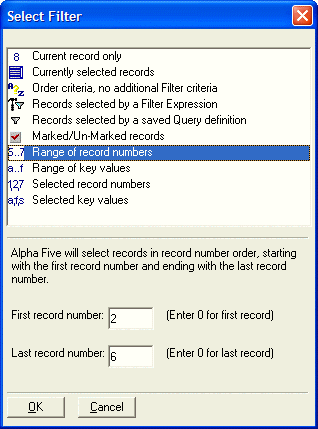UI_GET_RANGE Function
Syntax
Arguments
- Range_Expn
A pointer to a dot variable that contains the current filter and order expressions.
- Argument
- Details
- .error_message
Type "C", Any error message generated by the dialog box.
- .filter
Type "C", The filter expression that the operator defined. See Query.Filter
- .flag
Type "L", The sort values that the operator defined. See Query.Options.
- .lastbutton
Type "C", The button that the operator pressed in the dialog box.
- .order
Type "C", The order expression that the operator defined. See Query.Order.
- .Xbasic.filter
Type "C", Process this Xbasic statement with EVALUATE_TEMPLATE()to apply the filter expression defined by the operator.
- .Xbasic.order
Type "C", Process this Xbasic statement with EVALUATE_TEMPLATE()to apply the order expression defined by the operator.
- top_level_only
Optional. Default = .F.
- .T. = Top level table of set.
- .F. =
- flag_external_tableset
Optional. Default = .F.
- .T. = The query is against an external table or set.
- .F. = The query is against a local table or set.
- external_tableset_name
Optional. The name of the external table or set.
Description
The UI_GET_RANGE() function displays the Select Filter dialog box to help the user select a filter or range for the current table or set.
Example
? ui_get_range(.f.) = error_message = "" filter = "between(recno() ,2,6)" flag = .F. lastbutton = "ok" order = "recno() " Xbasic = query.filter = "between(recno() ,2,6)" query.order = "recno() "
If you need to define filter or order expressions for a table or set that is not currently open, use a variation of this script, which retrieves the filter and order information for the invoice set.
code = <<%code%
dim s as P
dim filter as P
s = set.open("invoice.set")
filter = ui_get_range()
if filter.lastbutton = "OK" then
ui_msg_box("", filter.filter)
else
ui_msg_box("", "user cancelled")
end if
s.close()
%code%
evaluate_template_private(code)Limitations
Desktop applications only.
See Also
